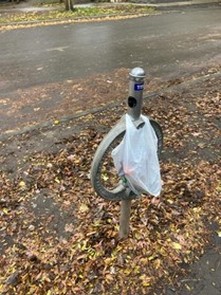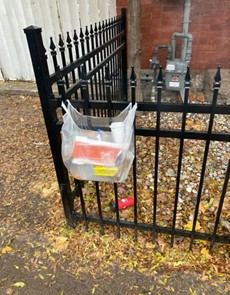ASH’s Position
ASH is committed to maintaining Sandy Hill as a diverse, historic, and green community within a vibrant neighbourhood which welcomes people from all walks of life, including those who may be struggling with poverty, addiction, and mental health. At the same time, ASH notes that Sandy Hill is negatively impacted from externalities related to the density of services and providers in the community, particularly given the location of these in residential areas and in non-residential zones adjacent to residential zones. The way the City of Ottawa serves the vulnerable population in our community has not considered the externalities and as such has not developed the community’s capacity to cope with these. What is needed are appropriate safeguards, resources, and amenities to support all those who live, work, and play in Sandy Hill.
In 2020, the City of Ottawa spent an estimated $8.4 million on shelters and day programs, including the Ottawa Mission, Centre 454, St. Joe’s, and Jail Hostel in Sandy Hill. Shelters provide a bed for the night. Soup kitchens and day programs provide meals, a place to hang out or otherwise shelter from the elements, and basic amenities such as showers and restrooms. Supervised consumption sites, which are primarily funded and mandated by the province, are supported to make sure drug users are safe when using drugs. These services are necessary.
However, there are externalities associated with the provision of these services. The more shelters and social services are concentrated in a small area, the higher the cost of these externalities such as social disorder, threats to personal safety, excess garbage, and increased pressure on community resources.
The problem is not with the shelters, social service providers, and the supervised consumption sites. The problem is that decision-makers have not considered the impacts of these on the neighbourhoods in which they are located and defer the responsibility onto the providers and community.
The most glaring example of the City’s failure to consider the possible ramifications of the intensification of services is this: There are only two needle drop boxes in Sandy Hill. There is one outside of the Fire Station along King Edward Ave and the other is outside of the SHCHC on Nelson St.
Supervised consumption sites (SCS) are an integral part of the solution. They offer individuals who use illegal drugs a place to inject or inhale in a monitored environment, provide access to clean drug use equipment and safe disposal after use as well as emergency care in the event of medical crisis. They are intended to reduce harm to both the user and to the community. Overdoses and accidental death are diminished when drugs are consumed in a hygienic environment under medical care, as is public drug consumption in places like restrooms, parks, streets, and alleys.
Supervised consumption sites, such as the one operated out of SHCHC, have been successful in offering life-saving services and pathways to treatment as well as in connecting people to other social services. The evidence shows that they work. When properly established, supervised consumption sites can be effective in reducing harm to both users and to the communities in which they are situated. (Unfortunately, the SCS at the SHCHC has had to decrease its hours of services due to staff shortages, the ongoing pandemic, and other considerations. It now operates 9am to 5pm Monday through Friday. Those who suffer from addiction suffer 24/7.)
So why has Sandy Hill not seen a reduction in public drug use? Why has it instead experienced a steady increase in discarded drug equipment? And why hasn’t the city invested in affordable housing and supportive housing? Harm reduction services should be established throughout all Wards in the City of Ottawa to deliver fair, equitable, and accessible health care and essential services to all those who require them.
Data from the City of Ottawa also shows that the number of improperly discarded drug equipment in the community has grown in this period. From 2015 to 2020, the number of used needles discarded in the community quadrupled. In 2020, 22,845 improperly discarded syringes were collected from streets, sidewalks, and parks in our community. This represents 76% of the city-wide total. The number of 311 calls related to improperly discarded needles have increased by 54% during the pandemic.
The harm reduction benefits of supervised consumptions sites have not borne out in our community.
Needles Retrieved in Ward 12 (Sandy Hill, Lowertown and Vanier)
The COVID-19 pandemic has further exacerbated conditions, particularly for vulnerable populations but also for all others who live, work, and play in the community. Although the City of Ottawa opened several respite centres during the pandemic, many people who previously relied on the washroom facilities of local businesses, shopping centres, grocery stores, and public libraries suddenly had no place to go. This has resulted in increased incidents of public urination and defecation in parts of our community.
The lack of clean, safe, and accessible public toilets in our community represents a public health failure. Public toilets are essential infrastructure support for a healthy, equitable, and clean society. It also ensures human dignity for those who, due to various health conditions, pregnancy, or a lack of permanent housing, require access to public washrooms.
In addition to the lack of clean, safe, and accessible public washrooms, the pandemic has revealed other gaps in Sandy Hill’s capacity to cope with the existing concentration of shelters and social services. For instance, the pandemic forced many shelters and providers to shift to a takeaway model of food delivery. As a result, residents and business owners near those areas have observed an increase in the amount of garbage (i.e., takeaway food packaging in those areas. This is not to suggest that those who are unhoused are more likely to litter than those who are not, but rather to illustrate that the lack of garbage receptacles puts an unfair burden on those who cannot simply hold onto their trash until they are home.
These photographs, which were taken in Sandy Hill in fall 2021, show that those who are unhoused often go to lengths – improvising waste bins – to keep their community clean of litter. Garbage and recycling receptacles are essential for clean and safe communities, and should be found in all areas where people, including those who are unhoused tend to congregate, as well as along the sidewalks where people frequent and traverse.
The pandemic has highlighted the fact that Sandy Hill is severely underserved by garbage and recycling receptacles. This, in turn, contributes to the proliferation of rats. Ottawa is now the fourth most rat-infested city in Canada in part due to the City’s parochial view towards garbage bins. The City’s policy on the placement of garbage receptacles limits these to so-called main streets – and not necessarily where people are traversing, eating, or congregating. In Sandy Hill, this means Laurier Ave and Rideau St. The population of Sandy Hill is not served by an adequate number of garbage and recycling receptables. The placement of which should consider the commuting patterns and the location of businesses, shelters, and social service providers.
ASH’S SOLUTIONS
Limit the intensification of shelters and social services
Action Sandy Hill calls on the City of Ottawa to limit the number of shelters and social services in our community, as per its 2008 commitment. The fact that there are several shelters and social services currently operating outside of Sandy Hill and Ward 12, indicates that the needs of the homeless and those at risk of becoming homeless exist elsewhere.
Instead, the City should ensure an equitable distribution of shelters, group homes, social services, community health and resource centres, and harm reduction facilities. This reduces barriers of accessibility for those who suffer from addiction, trauma, or mental health, or are homeless or at risk of becoming homeless.
More importantly, the City should tackle the housing crisis by divesting from antiquated emergency shelters and pursue Housing First model. Housing First, which includes supportive housing options for those who need special care or assistance, gets people off the street and into their own permanent homes.
Invest in Infrastructure and Community Capacity
Clean, safe, and accessible public toilets
Clean, safe, and accessible public toilets should be installed in our community. This is a matter of public sanitation and safety. Given the level of human waste in our community, the City of Ottawa should consider this issue to be an essential public health matter and treat it with the same importance as that afforded to other types of public infrastructure. The City of Montreal has announced plans to build 12 public toilets in high traffic areas. Ottawa should do the same.
The City should consider all cost options of increasing the number of public washrooms in Sandy Hill, including self-cleaning models such as the one to be installed in the ByWard Market, as well as other lower-cost options such as the Portland Loo and porta-potties, particularly in public spaces such as park and in areas to serve the unhoused population.
Porta-potties should be immediately installed outside of all the shelters and social services facilities in Sandy Hill so that 24/7 access can be assured to all those who need it.
Garbage and Recycling Receptables
Garbage and recycling receptables should be placed in all high-traffic areas in our community. This includes the area immediately outside all the shelters and social services in Sandy Hill. These should also be stationed along all high-traffic roads and sidewalks, such as Cumberland, Nelson, and Chapel Streets.
In addition to increasing the number of waste receptacles in Sandy Hill, the City of Ottawa should also increase the frequency of street sweeping in our community.
Bio-Hazardous Waste
Sandy Hill has seen a steady increase in the number of improperly discarded drug equipment in the community. While the City of Ottawa prioritizes 311 calls to remove bio-hazardous waste, it does not collect these from private properties such as residences or businesses. The Needle Hunters program is also prohibited from collecting discarded drug debris from private property.
The City of Ottawa must increase the number of needle drop boxes in Sandy Hill. Despite the high volumes of 311 calls and the data held by Ottawa Public Health, there are currently only two in Sandy Hill: at SHCHC and at the Fire Station. The latter location is not likely to attract those who may be using illegal drugs.
Ottawa Public Health (OPH) should install needle drop boxes outside of all the shelters and social service providers in Sandy Hill. Agencies that provide clean drug kits have an ethical obligation and responsibility to the neighbourhoods in which they are located as well as to their clientele to provide safe disposal of used needles. In adjacent neighbourhoods, OPH has placed needle drop boxes outside of all City-run public housing facilities and should do the same in Sandy Hill. ASH is currently working with OPH to push for more needle drop boxes in our community.



